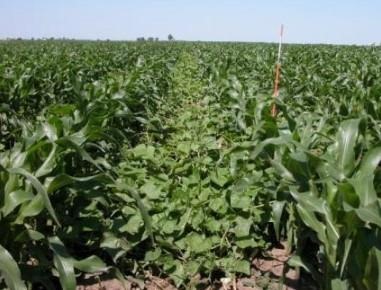By Prashant Jha and Rebecca Vittetoe
With harvest winding down, one weed that made harvest more frustrating for some is burcucumber. Consequently, there have been many questions on how to better manage this weed to prevent those frustrations.
Burcucumber (Sicyos angulatus) is an aggressive, viny, summer annual broadleaf weed that can be troublesome in corn and soybean fields. Key identifying characteristics of burcucumber are round to heart-shaped leaves, sticky hairy and ridged stems, vines with long tendrils, and spiny seed clusters (bur-like seeds). Burcucumber seedlings have large, oval-shaped cotyledons and will emerge late into the growing season (Werle et al. 2014). Burcucumber may be confused with the less common wild cucumber (Echinocystis lobata); however, wild cucumber is less likely to invade into crop fields.
Burcucumber vines can grow over 20 feet long and twine around corn plants, thereby lodging the corn plants and causing severe harvest problems. Burcucumber begins to flower in August and continues flowering until a killing frost. Seed clusters are composed of up to 30 seeds. The hard seed coat contributes to a prolonged seed dormancy, thereby contributing to persistence and infestation of this weed for several years in crop fields.
An integrated weed management program as highlighted below is needed to effectively manage burcucumber in corn and soybean fields.
- Burcucumber seeds are much larger than the seeds of most weed species found in Iowa corn and soybean fields. Previous research indicate that seeds can germinate and emerge from soil depths up to 6 inches, with an extended emergence period.
- Tillage may not be the best solution as it can potentially encourage multiple flushes of burcucumber during the growing season. If burcucumber is a problem, keeping the field under no-till conditions, where seeds are left near the soil surface and are less likely to germinate, may be a better option.
- Research conducted at Penn State suggests that burcucumber has a shorter emergence period under no-till conditions; thus, can be more effectively controlled by herbicides in no-till fields compared to conventional tillage.
- Burcucumber produces a relatively small number of seeds; thus, a large seedbank is not expected, and with an effective weed management program in corn and soybean, the infestation can be reduced drastically in a few years.

Figure 1. Burcucumber infestation in a corn field in Iowa.
Herbicide programs in corn
- Because burcucumber can emerge in multiple flushes throughout the growing season, an effective control must include a two-pass, PRE followed by POST herbicide program. POST programs should include an effective residual herbicide to control late-emerging burcucumber flushes.
- Effective two-pass programs in corn include PRE products containing atrazine and/or isoxaflutole (Balance flex, Corvus + atrazine), and mesotrione and bicyclopyrone (Lexar, Acuron) followed by POST products such as dicamba (Status), mesotrione (Callisto/Halex GT), atrazine, glyphosate (Roundup Ready corn), and glufosinate (Liberty in Liberty-link corn).
- POST herbicide applications should be made when burcucumber plants are less than 12 inches long and have not started vining.
- For late-season applications of recommended products, drop nozzles may be needed for good coverage in tall corn. Late-season applications are only effective on small, late-emerging plants.
- If fields are heavily infested with burcucumber before corn harvest, application could be challenging in this scenario due to the significant vines. Parquet (Gramoxone) may be the most effective preharvest herbicide. Apply after black layer and at least 7 days before harvest. Follow the label for use restrictions.
Herbicide programs in soybean
- Soybeans planted in 30-inch rows may be advantageous if cultivation is an option; however, early canopy closure in soybeans planted in 15-inch rows can potentially reduce late-emerging burcucumber seedlings.
- Two-pass programs (PRE followed by POST) in soybean provide the best season-long control of burcucumber. Based on research conducted at Penn State, soil-applied PRE products that contain chlorimuron and/or metribuzin provide effective early-season control of burcucumber. These products include Authority MTZ, Authority XL, Canopy, Envive, Fierce XLT, Panther Pro, Valor XLT and others. Be mindful of carryover issues with some of these herbicides in high pH soils.
- Herbicides containing chlorimuron (Classic, Synchrony) have been found to provide the most consistent POST control of burcucumber.
- Glyphosate in glyphosate-resistant soybeans provides good control of burcucumber. In dicamba-resistant (Xtend) or 2,4-D-resistant (Enlist) soybean, registered dicamba or 2,4-D containing products, respectively, can be used in conjunction with glyphosate or chlorimuron. Glufosinate (Liberty) + AMS can be applied as a late-POST application in Xtendflex or Enlist E3 soybean to control late-emerging burcucumber plants.
- Burcucumber vines carrying seeds can wrap around reels of the combine. Seed can pass through a combine and be spread throughout the field or carried to other fields. Furthermore, burcucumber seeds are difficult to separate from corn or soybean seeds and can contaminate grain.
- Avoid harvesting heavily infested areas of the field for grain if possible. An important consideration for reducing the spread of burcucumber seeds would be to remove as many plants as possible from the infested field before harvest.
- Harvest fields that have the least amount of burcucumber before harvesting a more heavily infested field. More general information on at-harvest clean out to prevent weed seed spread can be found in this article.
Source : iastate.edu